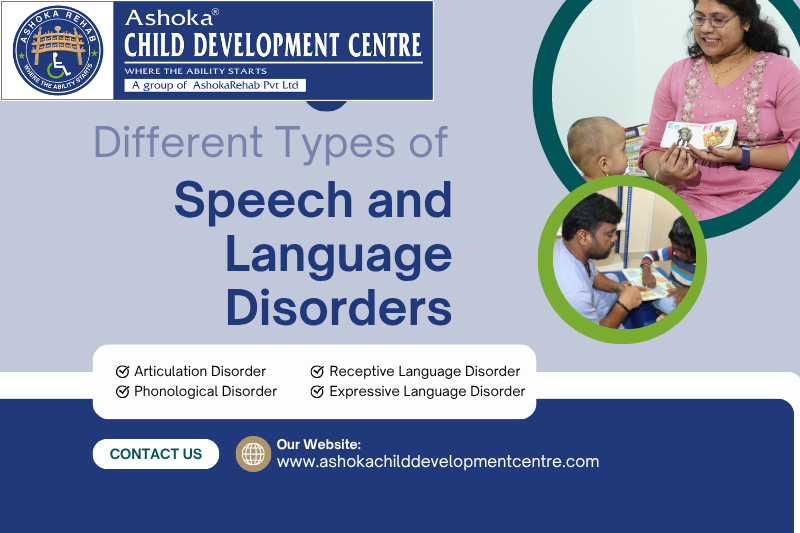Speech and language development plays a critical role in a child’s overall growth, learning, and social interactions. However, some children face challenges in expressing themselves, understanding language, or producing speech sounds correctly. These difficulties are referred to as speech and language disorders.
At Ashoka Child Development Centre, Hyderabad’s trusted centre for speech therapy, we believe early identification and intervention can make a huge difference in a child’s life. This blog will walk you through the different types of speech and language disorders, signs to look out for, and how professional help can support your child.
What Is the Difference Between Speech and Language?
Before diving into the types of disorders, it’s essential to understand the difference:
- Speech is how we say sounds and words (articulation, voice, fluency).
- Language is how we understand and use words to communicate (expressive and receptive).
A child may have a speech disorder, a language disorder, or both.
Types of Speech Disorders
1. Articulation Disorder
Children with articulation disorders have trouble producing specific sounds correctly. They may:
- Omit sounds (e.g., saying “nana” for “banana”; saying “ca” instead of “cat”)
- Substitute sounds (e.g., saying “wabbit” instead of “rabbit”; saying “thoup” instead of “soap”)
- Distort sounds (e.g., unclear or slurred speech; producing sounds in an unclear way)
- Additions (e.g., adding extra sounds like saying “buhlack” instead of “black”)
This is one of the most common types seen in young children.
2. Phonological Disorder
Here, the child can physically produce the sounds but uses them incorrectly by following incorrect sound patterns. For example:
- Using “gog” instead of “dog”
- Saying “tat” for “cat”
Phonological disorders affect the rules of sound usage and are more about patterns than individual sounds.
3. Fluency Disorder (Stuttering)
Children with fluency disorders struggle with the flow and rhythm of speech. Common signs include:
- Repeating sounds or syllables (e.g., “b-b-b-ball”)
- Prolonging sounds (e.g., “sssssnake”)
- Pauses or blocks in speech
Stuttering often begins in early childhood and may improve with early intervention.
4. Voice Disorder
This involves problems with pitch, volume, or quality of voice. The voice may sound:
- Hoarse or breathy
- Too loud or too soft
- High-pitched or nasal
Voice disorders can result from overuse of vocal cords or medical conditions like vocal nodules.
5. Motor Speech Disorders
These are related to the brain’s ability to plan and coordinate the muscles used for speech:
- Apraxia of Speech – difficulty planning and sequencing movements for speech.
- Dysarthria – weak or poorly coordinated speech muscles due to neurological damage.
Types of Language Disorders
1. Receptive Language Disorder
Children with receptive language disorders struggle to understand what others say. They may:
- Have difficulty following directions
- Not respond appropriately to questions
- Appear to ignore when spoken to
This affects learning and social interactions.
2. Expressive Language Disorder
Children with expressive difficulties struggle to use language to express themselves. They may:
- Speak in short or incomplete sentences
- Have a limited vocabulary
- Use incorrect grammar or word order
These kids may understand what others say but have trouble putting their thoughts into words.
3. Mixed Receptive-Expressive Language Disorder
This involves both difficulties—understanding and expressing language. Children may:
- Misunderstand instructions
- Struggle to form sentences
- Be late talkers with unclear communication
Therapy is crucial to help them bridge these communication gaps.
4. Pragmatic Language Disorder (Social Communication Disorder)
Children with pragmatic language issues struggle with the social aspects of communication. They may:
- Not understand turn-taking in conversations
- Struggle with non-verbal cues like gestures or facial expressions
- Use language in an unusual or inappropriate way
This is often seen in children with Autism Spectrum Disorder (ASD).
Causes of Speech and Language Disorders
Several factors can contribute, including:
- Developmental delays
- Hearing loss
- Autism Spectrum Disorder (ASD)
- Neurological conditions (e.g., cerebral palsy)
- Intellectual disabilities
- Genetic syndromes
- Premature birth or birth trauma
When to Seek Help?
If your child:
- Isn’t meeting communication milestones
- Is difficult to understand
- Has trouble forming sentences
- Doesn’t respond to names or simple instructions
- Gets frustrated while speaking
…it’s time to consult a speech-language pathologist.
How Ashoka Child Development Centre Can Help?
At Ashoka CDC, our speech therapists:
- Conduct thorough assessments to diagnose specific disorders
- Design customized therapy plans for your child
- Use engaging, evidence-based techniques (play therapy, articulation drills, AAC tools)
- Work in coordination with occupational therapists, psychologists, and special educators
We also provide parent training to help families support their child’s communication at home.
Conclusion
Speech and language disorders are more common than you might think—and with the right help, children can make remarkable progress. Whether your child has trouble speaking clearly, expressing ideas, or understanding language, early therapy can make all the difference.
Ashoka Child Development Centre is recognized as one of the best speech therapy centres in Hyderabad, offering expert care with compassion. Let us help your child find their voice.

